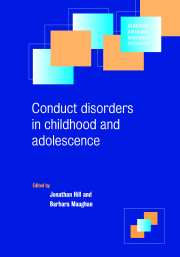Book contents
- Frontmatter
- Contents
- List of contributors
- Preface
- 1 Bad behaviour: an historical perspective on disorders of conduct
- 2 Can the study of ‘normal’ behaviour contribute to an understanding of conduct disorder?
- 3 The development of children's conflict and prosocial behaviour: lessons from research on social understanding and gender
- 4 Neural mechanisms underlying aggressive behaviour
- 5 Biosocial influences on antisocial behaviours in childhood and adolescence
- 6 The epidemiology of disorders of conduct: nosological issues and comorbidity
- 7 Conduct disorder in context
- 8 Genetic influences on conduct disorder
- 9 The role of neuropsychological deficits in conduct disorders
- 10 A reinforcement model of conduct problems in children and adolescents: advances in theory and intervention
- 11 Perceptual and attributional processes in aggression and conduct problems
- 12 Attachment and conduct disorder
- 13 Friends, friendships and conduct disorders
- 14 Continuities and discontinuities of development, with particular emphasis on emotional and cognitive components of disruptive behaviour
- 15 Treatment of conduct disorders
- 16 The prevention of conduct disorder: a review of successful and unsuccessful experiments
- 17 Economic evaluation and conduct disorders
- 18 Antisocial children grown up
- 19 Conduct disorder: future directions. An afterword
- Index
2 - Can the study of ‘normal’ behaviour contribute to an understanding of conduct disorder?
Published online by Cambridge University Press: 11 August 2009
- Frontmatter
- Contents
- List of contributors
- Preface
- 1 Bad behaviour: an historical perspective on disorders of conduct
- 2 Can the study of ‘normal’ behaviour contribute to an understanding of conduct disorder?
- 3 The development of children's conflict and prosocial behaviour: lessons from research on social understanding and gender
- 4 Neural mechanisms underlying aggressive behaviour
- 5 Biosocial influences on antisocial behaviours in childhood and adolescence
- 6 The epidemiology of disorders of conduct: nosological issues and comorbidity
- 7 Conduct disorder in context
- 8 Genetic influences on conduct disorder
- 9 The role of neuropsychological deficits in conduct disorders
- 10 A reinforcement model of conduct problems in children and adolescents: advances in theory and intervention
- 11 Perceptual and attributional processes in aggression and conduct problems
- 12 Attachment and conduct disorder
- 13 Friends, friendships and conduct disorders
- 14 Continuities and discontinuities of development, with particular emphasis on emotional and cognitive components of disruptive behaviour
- 15 Treatment of conduct disorders
- 16 The prevention of conduct disorder: a review of successful and unsuccessful experiments
- 17 Economic evaluation and conduct disorders
- 18 Antisocial children grown up
- 19 Conduct disorder: future directions. An afterword
- Index
Summary
Introduction
Conduct disorder embraces a wide spectrum of antisocial behaviours, only a proportion of which is necessary for diagnosis (Earls, 1994). That, and the fact that it is often associated with other conditions such as hyperactivity and cognitive impairment, suggest that it is far from being a clear-cut category. The variability in definitions of conduct disorder is highlighted by Angold & Costello (chapter 6, this volume), and the complexity of possible causal factors is illustrated by the range of chapters in this volume. It can be presumed that the causal factors interact in development: for instance, those antisocial children with an early onset of behavioural problems may have subtle neuropsychological problems which affect functions including language, memory and self-control (Moffitt et al., 1996; Lynam & Henry, chapter 9, this volume). These contribute to ‘difficult temperament’, and that in turn to an increased likelihood of exposure to negative environmental influences which exacerbate the condition (Kiesner et al., chapter 10, this volume).
An apparently complex symptomatology and etiology raises a number of questions, one being the extent to which it is reasonable to expect each individual symptom to depend on a relatively simple causal basis. To exemplify this issue, the initial discussion here centres on aggressive behaviour, though there is no implication that aggressiveness per se is central to conduct disorder or basic to its many symptoms.
Keywords
- Type
- Chapter
- Information
- Conduct Disorders in Childhood and Adolescence , pp. 32 - 48Publisher: Cambridge University PressPrint publication year: 2000

